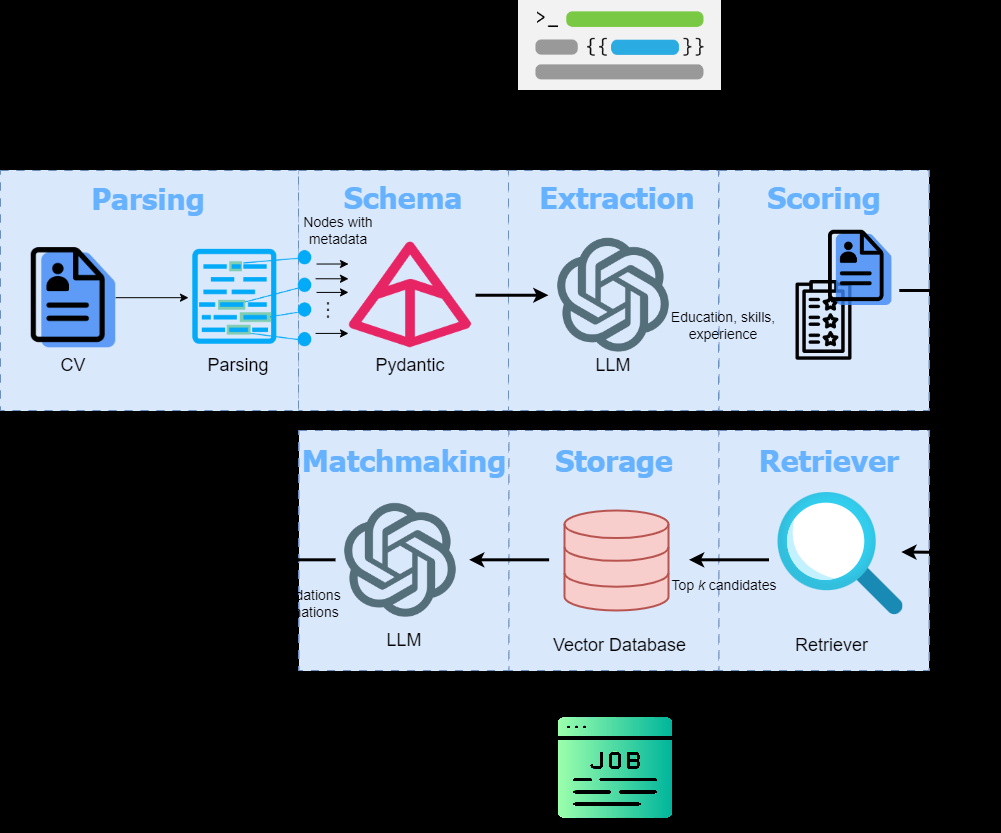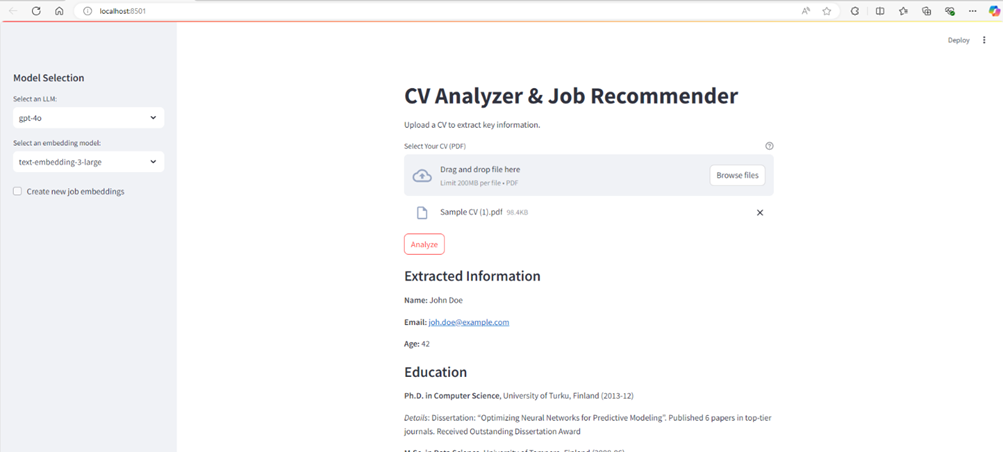AI-Powered Information Extraction and Matchmaking
This article explores using Large Language Models (LLMs) for information extraction from job seeker CVs and recommending suitable jobs. It leverages LlamaParse for document parsing and Pydantic for structured data extraction and validation, minimizing LLM hallucinations. The process involves: extracting key information (education, skills, experience), scoring skills based on their prominence in the CV, creating a job vector database, retrieving top job matches based on semantic similarity, and generating recommendations with explanations using an LLM.
A Streamlit application allows users to upload a CV (PDF), select LLMs (OpenAI's gpt-4o or open-source alternatives), and embedding models. The application then extracts the candidate's profile, computes skill scores (displayed as a star rating), and provides top job recommendations with explanations. The code uses OpenAI's API for the gpt-4o LLM and text-embedding-3-large embedding model, but offers flexibility to use open-source alternatives with a CUDA-enabled GPU.
The article details the Pydantic models for structured data extraction, showcasing their use in validating LLM output and ensuring data consistency. It explains the process of creating a job vector database from a curated JSON dataset (sample_jobs.json) and using cosine similarity to score skills based on their semantic relevance within the CV. The final job recommendations are generated using a Retrieval-Augmented Generation (RAG) approach, combining the extracted profile information with relevant job descriptions from the vector database.
The Streamlit application displays the extracted profile information (name, email, age, education, skills, experience) and the top job matches, including company details, job descriptions, location, employment type, salary range (if available), URL, and a brief explanation of the match. The skill scores are visually represented using a star rating system.
The article concludes by suggesting areas for improvement and expansion, including: improving the job database ingestion pipeline, expanding the profile information extracted from CVs, refining the skill-scoring method, extending the application to match job ads with candidate profiles, testing the application with diverse CV formats, and providing CV improvement and upskilling recommendations. The complete code is available on GitHub. The author encourages readers to clap, comment, and follow them on Medium and LinkedIn.


The above is the detailed content of AI-Powered Information Extraction and Matchmaking. For more information, please follow other related articles on the PHP Chinese website!

Hot AI Tools

Undress AI Tool
Undress images for free

Undresser.AI Undress
AI-powered app for creating realistic nude photos

AI Clothes Remover
Online AI tool for removing clothes from photos.

Clothoff.io
AI clothes remover

Video Face Swap
Swap faces in any video effortlessly with our completely free AI face swap tool!

Hot Article

Hot Tools

Notepad++7.3.1
Easy-to-use and free code editor

SublimeText3 Chinese version
Chinese version, very easy to use

Zend Studio 13.0.1
Powerful PHP integrated development environment

Dreamweaver CS6
Visual web development tools

SublimeText3 Mac version
God-level code editing software (SublimeText3)

Hot Topics
 AI Investor Stuck At A Standstill? 3 Strategic Paths To Buy, Build, Or Partner With AI Vendors
Jul 02, 2025 am 11:13 AM
AI Investor Stuck At A Standstill? 3 Strategic Paths To Buy, Build, Or Partner With AI Vendors
Jul 02, 2025 am 11:13 AM
Investing is booming, but capital alone isn’t enough. With valuations rising and distinctiveness fading, investors in AI-focused venture funds must make a key decision: Buy, build, or partner to gain an edge? Here’s how to evaluate each option—and pr
 AGI And AI Superintelligence Are Going To Sharply Hit The Human Ceiling Assumption Barrier
Jul 04, 2025 am 11:10 AM
AGI And AI Superintelligence Are Going To Sharply Hit The Human Ceiling Assumption Barrier
Jul 04, 2025 am 11:10 AM
Let’s talk about it. This analysis of an innovative AI breakthrough is part of my ongoing Forbes column coverage on the latest in AI, including identifying and explaining various impactful AI complexities (see the link here). Heading Toward AGI And
 Build Your First LLM Application: A Beginner's Tutorial
Jun 24, 2025 am 10:13 AM
Build Your First LLM Application: A Beginner's Tutorial
Jun 24, 2025 am 10:13 AM
Have you ever tried to build your own Large Language Model (LLM) application? Ever wondered how people are making their own LLM application to increase their productivity? LLM applications have proven to be useful in every aspect
 Kimi K2: The Most Powerful Open-Source Agentic Model
Jul 12, 2025 am 09:16 AM
Kimi K2: The Most Powerful Open-Source Agentic Model
Jul 12, 2025 am 09:16 AM
Remember the flood of open-source Chinese models that disrupted the GenAI industry earlier this year? While DeepSeek took most of the headlines, Kimi K1.5 was one of the prominent names in the list. And the model was quite cool.
 AMD Keeps Building Momentum In AI, With Plenty Of Work Still To Do
Jun 28, 2025 am 11:15 AM
AMD Keeps Building Momentum In AI, With Plenty Of Work Still To Do
Jun 28, 2025 am 11:15 AM
Overall, I think the event was important for showing how AMD is moving the ball down the field for customers and developers. Under Su, AMD’s M.O. is to have clear, ambitious plans and execute against them. Her “say/do” ratio is high. The company does
 Future Forecasting A Massive Intelligence Explosion On The Path From AI To AGI
Jul 02, 2025 am 11:19 AM
Future Forecasting A Massive Intelligence Explosion On The Path From AI To AGI
Jul 02, 2025 am 11:19 AM
Let’s talk about it. This analysis of an innovative AI breakthrough is part of my ongoing Forbes column coverage on the latest in AI, including identifying and explaining various impactful AI complexities (see the link here). For those readers who h
 Chain Of Thought For Reasoning Models Might Not Work Out Long-Term
Jul 02, 2025 am 11:18 AM
Chain Of Thought For Reasoning Models Might Not Work Out Long-Term
Jul 02, 2025 am 11:18 AM
For example, if you ask a model a question like: “what does (X) person do at (X) company?” you may see a reasoning chain that looks something like this, assuming the system knows how to retrieve the necessary information:Locating details about the co
 Grok 4 vs Claude 4: Which is Better?
Jul 12, 2025 am 09:37 AM
Grok 4 vs Claude 4: Which is Better?
Jul 12, 2025 am 09:37 AM
By mid-2025, the AI “arms race” is heating up, and xAI and Anthropic have both released their flagship models, Grok 4 and Claude 4. These two models are at opposite ends of the design philosophy and deployment platform, yet they







